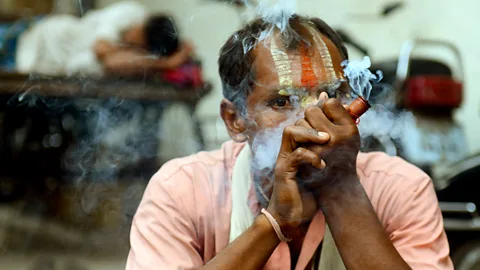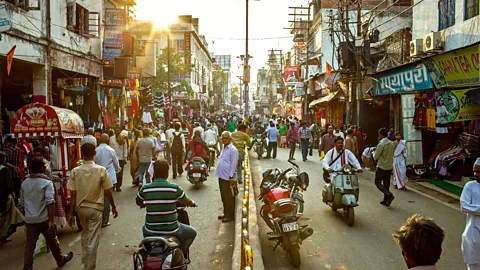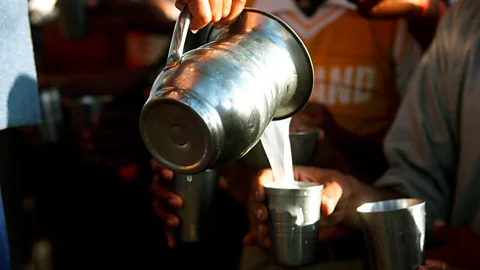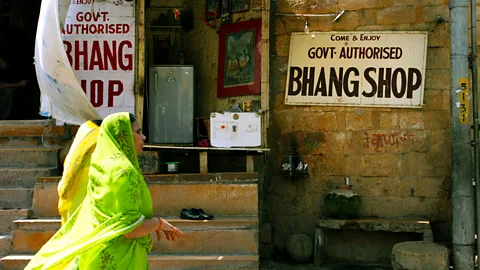The intoxicating drug of an Indian god
 Diptendu Dutta/Stringer/Getty
Diptendu Dutta/Stringer/GettyThe cannabis plant’s role in Hindu mythology has authorities turning a blind eye to India’s drug shops.
I made my way down Varanasi’s winding, narrow alleyways, bound by walls stained with the distinctive red marks of paan (a leaf often used to flavour chewing tobacco) spat out by hundreds of passers-by. I was headed to one of the city’s oldest neighbourhoods, known as Godowlia Chowk, in search of the Kashi Vishwanath Thandai Ghar, a tiny street stall owned by Kamlesh Kumar Pathak. The stall is famous for one item, thandai.
 The Washington Post
The Washington PostThe milk-based, mildly spiced Indian beverage comes in flavours like apple, mango and papaya. However, the most popular order at Pathak’s stall, known as ‘special thandai’, is made with a dash of freshly ground bhang, an intoxicant made from the leaves of the female cannabis plant.
Bhang has long been of cultural significance in India. In Hinduism, bhang takes on special meaning as the plant preferred by Shiva, the god of destruction, who was believed to have used bhang to focus inward and to harness his divine powers for the good of the world.
In the Atharva Veda, one of the four sacred texts of Hinduism, cannabis is named one of the five most sacred plants on Earth. The text also refers to it as a ‘source of happiness’ and a ‘liberator’.
 Dinodia Photos/Alamy
Dinodia Photos/AlamyAlthough the Narcotic Drugs and Psychotropic Substances Act of 1985 prohibits the production, sale and consumption of certain parts of the cannabis plant, the leaves are an exception. There are even government-approved bhang shops in towns like Jaisalmer and Pushkar, and more than 200 such shops – including Pathak’s – exist year-round in Varanasi. The intoxicating ingredient has always been popular with India’s Brahmin community, who were traditionally forbidden from imbibing inebriants like alcohol. In some especially religious parts of the country, including Varanasi, it is common to see babas and sadhus (holy men) consuming bhang directly or smoking it from a clay pipe known as a chillum.
Pathak’s family has been serving bhang at the famous Kashi Vishwanath temple in Varanasi, dedicated to Shiva, for more than 150 years. Pathak sources the raw material each day from his local government-sanctioned shop. He soaks it in warm water, and then grinds it into a coarse paste with a flat mortar and pestle to get it ready for consumption.
“This is the traditional baba ka prasad presented at 3 am every day, during the Mangal Aarti,” he said, referring to the pious offering of a special thandai made to Shiva by devotees during the early-morning prayer ceremony.
 Aroon Thaewchatturat/Alamy
Aroon Thaewchatturat/AlamyBhang also plays an important role in Hindu celebrations like Shivrati (known as the 'night of Shiva') and Holi (the festival of colours). During these times, the addition of bhang to a traditional thandai heightens the general sense of merriment on the streets. Pathak says he serves more customers than usual on festival days.
The first – and only – time I tried a special thandai had been during the Holi festival several years earlier. My experience started with an initial happy haze, followed by a paranoid funk that lasted for hours. As I observed a few of Pathak’s regulars queue up for the intoxicating beverage, I marvelled at their ability to consume it regularly.
Although thandai is the most common base, bhang is also blended into lassi, a popular churned and sweetened yoghurt drink. Close to the Vishwanath temple is another local institution, the Blue Lassi Shop, featuring more than 80 variants of the beverage on its menu – and one unadvertised ‘special’ available only to those who specifically ask for it.
 Hindustan Times/Getty
Hindustan Times/GettyBhang is also mixed into savoury snacks like pakora (fried balls of chickpea flour) or into the chutneys and pickles that accompany other popular fried snacks like samosa and kachori. Many of the government-authorised shops also sell sweetened bhang in the form of laddoos, a traditional Indian dessert.
Additionally, bhang is believed to have medicinal properties when administered in moderate doses. One of Hinduism’s best-known legends describes a plot by several gods and demons to churn the ocean to release a nectar of immortality. When Shiva intervened to drink up the halahala poison that also emerged during the churning, it turned his throat blue (earning him the name Neelkanth, or Blue-throated) and caused him great agony. Parvati offered him ground bhang to soothe the pain.
When the British established rule over India in the mid-1800s, they were initially astounded at such widespread use of bhang in the country; in the late 19th Century, they commissioned a study of the drug’s effects and cultural significance.
“To forbid or even seriously restrict the use of so holy and gracious an herb as the hemp would cause widespread suffering and annoyance,” the report said. “It would rob people of solace in discomfort, of a cure in sickness, of a guardian whose gracious protection saves them from attacks of evil influences.”
 Diptendu Dutta/Stringer/Getty
Diptendu Dutta/Stringer/GettyTo this day, bhang plays a significant role in Indian spirituality and culture. However, I have steered clear of it since that memorable morning during the Holi festival.
Join over three million BBC Travel fans by liking us on Facebook, or follow us on Twitter and Instagram.
If you liked this story, sign up for the weekly bbc.com features newsletter called "If You Only Read 6 Things This Week". A handpicked selection of stories from BBC Future, Earth, Culture, Capital, Travel and Autos, delivered to your inbox every Friday.